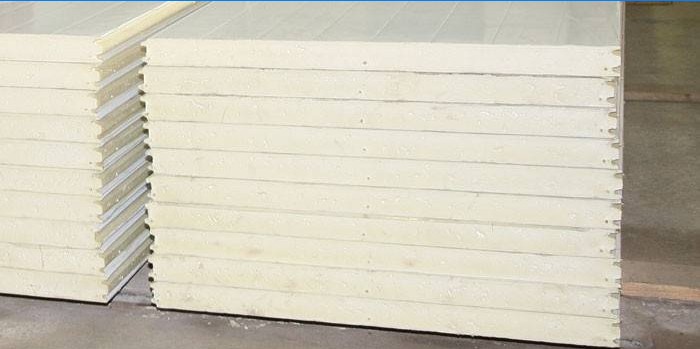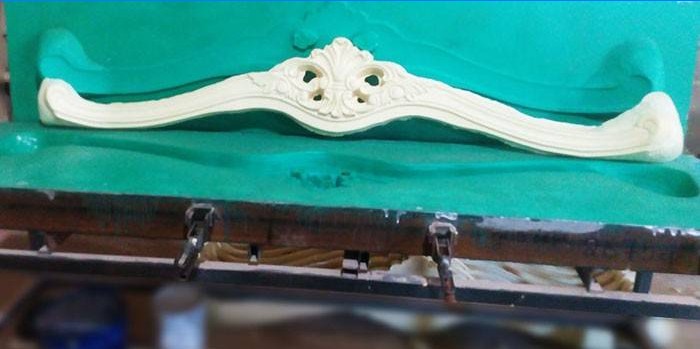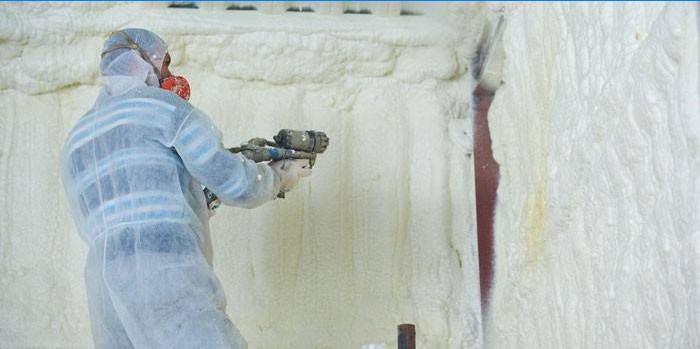The content of the article
- PPU material
- Production
- Types of PPU and release forms
- Specifications
- Application
- PPU just for decoration
- Polyurethane foam insulation
- Pros and cons of PPU
- Safety
- How to choose polyurethane foam
- PPU prices
A group of scientists from Germany led by Otto Bayer in 1937 created a multifunctional material – polyurethane foam. It can be flexible and resilient, but not tensile, or hard and dense, but brittle when bent. Mass production of PPU began in the 1960s. Since then, the samples have been improved, many varieties of the compound have appeared. What is polyurethane foam, what is it like?
PPU material
Polyurethane foam is a gas-filled plastic based on polyurethanes, 85-90% consisting of an inert gas phase. The material is hard, soft, elastic, due to this it is used in all areas of human activity:
- serves as a filler for upholstered furniture, car seats, children’s toys, sleeping accessories;
- sponges for washing dishes, dust filters, paint rollers, polyurethane foam, shock-absorbing packaging and not only are made from it.
Production
Raw materials for polyurethane foam – petrochemical industry products: polyisocyanates and polyols. Also, components for polyurethane foam are made from vegetable oils: castor, rapeseed, soy, and sunflower. Biogenic foam components have not found application in industry, since they require considerable financial investments, their use is limited by a narrow range of specific tasks.
Between petroleum products (polyol and polyisocyanate), mixed in certain proportions, chemical reactions take place. After the first conversions, a small amount of water is added to the reaction mixture, carbon dioxide begins to be released. The reaction results in a foam filled with CO2. The mechanical indicators and properties of polyurethane, i.e., density and structure, determine the size of the chain of gas-filled microspheres, the proportion of the starting polymers, the presence of flame retardants.
Types of PPU and release forms
Polyurethane foam is divided into soft (density 5-40 kg / m3) and solid (30-86 kg / m3). The first group is foam rubber. The chemical industry produces foam rubber of different densities:
- standard (ST), maximum load 60-100 kg / cm2;
- hard (HL), 80-120 kg / cm2;
- soft (HS), 60-120 kg / cm2;
- increased rigidity (EL), 60-100 kg / cm2;
- highly elastic (HR), 100-120 kg / cm2;
- highly elastic, fireproof, special purpose (CMHR), 100-120 kg / cm2.
Foam rubber of all grades, with the exception of CMHR, refers to highly combustible substances according to GOST 30244. GOST 30402 defines a chemical compound as flammable, and GOST 12.1.044 as smoke-forming, toxic when burning. Soft PPU is not used in construction. In this area, rigid polyurethane foam is used – a substance with flame retardants. Heat and noise insulation coatings are made from formations with a density of 30-70 kg / cm3 or sprayed raw materials, and superdense types (70-86 kg / cm3) are used for waterproofing in foundations, on other surfaces.
The chemical industry produces material in various forms:
- sheet – hard or soft, rectangular, 5-1000 mm thick;
- rolled – soft, wound into bobbins of different widths, the thickness of the material is 2-30 mm, may have a substrate of fabric or synthetics;
- block – rectangular blocks of foam with a rigid non-porous crust, which is completely or partially removed after cooling the foamed mixture;
- acoustic – individual panels with a figured relief, are distinguished by a high coefficient of sound absorption;
- contour – parts that have a curved shape (seats, backs, armrests) are performed on the basis of the drawing;
- crumbs – crushed high-density polyurethane foam from plates or shells, fraction size – 10-30 mm;
- liquid – spray coating.

Specifications
Different types of PUFs differ in technical characteristics. Polyurethane foam is divided into two groups:
- Open cell. It consists of open interconnected cells. Elastic, with a spongy structure, quickly foams, increases in volume. Provides good sound insulation. Unstable, characterized by high rates of vapor permeability, moisture absorption. Not recommended for outdoor insulation. In construction, open-cell rigid polyurethane foam of ultra-low densities (8-10 kg / m3) is used.
- Closed cell. It consists of a system of closed cells filled with gas. The thermal conductivity of gas is lower than that of air. This makes PPU the most effective heat insulator. The material has high strength and good density. It is light and hard, with low vapor permeability, low thermal conductivity. Closed-cell connection adheres firmly to paper, metal, wood, plaster, etc..
The table shows the main technical characteristics of two types:
| Parameters, properties | Open cell | Closed cell |
| Number of Closed Cells | Less than 50% | More than 92% |
| Density | 8-20 kg / m3 | 25-300 kg / m3 |
| Coefficient of thermal conductivity | 0.03-0.04 | 0.019-0.030 |
| Expansion (rise of foam) in comparison with the initial volume | 100: 1 | 30: 1 |
| Hygroscopicity | 15-100% | 1-3% |
| Vapor permeability | 0.06-0.08 | 0.02-0.05 |
| Waterproofing | Not suitable | Fit |
| Soundproofing | High | Average |
Application
Universal material is used in almost all industries:
- Automotive: car seat filler, vehicle interior insulation.
- Mechanical engineering: refrigerant insulator in domestic and commercial refrigerators, large refrigeration chambers, transport refrigeration equipment, medical installations.
- Transport: heat insulators of main pipelines, insulators of low-temperature pipelines of the chemical industry.
- Shoe: production of arch support and other items of footwear.
- Furniture: soft polyurethanes are used as a filler, cushioning material for upholstered furniture.
- Lightweight: PPU filler is used when sewing soft toys, mattresses, pillows, mannequins.
- Construction: sandwich panels, acoustic insulation, waterproofing, heat-insulating raw materials for residential and industrial premises, warehouses, garages, hangars. For closing cracks, the space between loose parts, urethane carpentry glue is used..
PPU just for decoration
Chemical compound is a technological analogue of springs. It is simpler and cheaper to manufacture, in terms of performance, it does not lag behind, and in many cases even surpasses springs. Furniture polyurethane foam is available in various forms:
- Sandwich or block. This is a “brick” of large sizes. During the production process, furniture factory workers cut it into layers of different shapes and thicknesses. Then, experts combine hard and soft layers, folding them into seats, backs.
- Cast. It is made at a furniture factory. A shaped blank is filled with a liquid mixture, a chemical reaction takes place in it, and the polyurethane foam hardens under pressure. The final product takes the exact size and shape of a sofa cushion or seat. Pros – no scraps, minuses – a “crust” forms on the surface of the block, which does not allow air to pass through. The price of sofas with cast PPU is higher than on models with a block lining.
For furniture, soft polyurethane foam with a density of 30-40 kg / m3 is used. The higher the indicator, the stiffer and more durable the product. Low-density polyurethane foam (up to 25 kg / m3) is suitable for decorative pillows. There are several varieties of materials with a polyurethane foam base: Lokfoam, Vibrofoam, Fomex (USA), Moltoprene (Germany), Allofoam (Canada). Their characteristics are similar to domestic PPU.
Particularly noteworthy are the compounds with the memory effect (memoform, memorix). Thanks to special additives, the material is highly elastic. He knows how to keep the shape of a seated person, perfectly adapts to the bends of the body. When a person rises, the memorix quickly straightens. Initially, memory foam polyurethane was developed for NASA, but then became popular in the light industry..
The manufacturer promises a comfortable sleep, because Memorix gently envelops the body without squeezing the blood vessels. Highly flexible polyurethane foam also has disadvantages, and significant ones. After unpacking, customers feel a toxic smell that does not always disappear even after a week. There is no question of environmental friendliness and safety for health, because after examination in the memorix sample, toxins were found that cause allergies, asthma, eye irritation, and headaches. Hydrocarbons emit a bitter-sweet smell, affect the nervous and immune systems.
In Western countries with enhanced environmental safety controls, Memorix does not contain hazardous chemical components. Sanitary standards in the CIS countries are not so strict. Some people are ready to buy pillows and mattresses Memorix is very expensive, endure an unpleasant aroma, because after sleep they pass pain in the back and neck. There are rave reviews about the memorial on the network – buyers of quality goods are very pleased with the purchase.

Polyurethane foam insulation
For the insulation of structures of any type, a liquid mixture is used. It is applied by spraying. Using special equipment, polyurethane foam is sprayed onto a wall, foundation, roof or various containers, which instantly increases in volume, fills cavities and crevices. The composition hardens after 5-10 minutes. The monolithic porous “fur coat” adheres firmly to the surface, has no seams and joints, therefore it reliably protects against leakage or heat penetration (actual in summer when the air conditioning system is working).
The number of closed cells is more than 92%, and for the best samples – 97-98%. Thermal conductivity reaches 0.019-0.035 W / m · ° C. This indicator is the lowest among other heaters – polystyrene foam, polystyrene foam, polyethylene foam. Thermal insulation PPU is characterized by good moisture resistance. To reduce hygroscopicity, additives are introduced into the composition. Castor oil reduces hydrophilicity by 4 times. Polyurethane foam is resistant to basic chemical compounds: insoluble in gasoline, diesel fuel. The service life of the “fur coat” is 20-30 years.
For warming, ready-made thermo-insulating polyurethane foam parts are still used: blocks, panels, half-cylinders (shell for pipes), but they lose to the liquid PPU in demand. The latter is applied not only to exposed surfaces, but also serves as an intermediate layer in sandwich panels. The combustibility class of the substance is G2 and G3. The compound is not an active source of combustion; it immediately goes out if fire is removed from it..
Pros and cons of PPU
Technical characteristics determine the advantages of polyurethane foam. Product advantages of the chemical industry:
- Excellent adhesion – good adhesion to other materials. The surface shape and curvature do not matter. Polyurethane foam does not require additional fasteners and special surface treatment.
- The heat-insulating coating does not burden the walls and the rafter system, which is especially important for the roof, strengthens surfaces, prevents their destruction, protects metals from corrosion.
- It withstands a wide temperature range: from -100 to +150 ° C. Not destroyed by wind and precipitation.
- It is characterized by biological resistance: PPU does not affect mold, the material is not of interest to rodents – they do not make burrows in the thermal insulation coating.
- As a filler for furniture, the material also has a lot of advantages. It does not accumulate dust, is hypoallergenic, has good breathability, elasticity, quickly restores its original shape.
Almost 70% of PPU deficiencies depend on the quality of raw materials and installation work, the remaining 30% are features of the material itself. Briefly about the negative sides of polyethylene foam of different densities:
- Exposure to sunlight is detrimental to thermal insulation foam. Under the influence of UV rays, the “coat” is destroyed, so it must be covered with a layer of paint, plaster or facing panels.
- PPU spraying is not suitable for all surfaces, for example, do not use it on fresh wooden log cabins. Moisture has not yet come out of them, and the “fur coat” holds water inside – this increases the risk of putrefactive processes.
- If a person ordered polyurethane foam too cheaply, then with a high probability the product belongs to the G4 combustibility class. It burns well and it’s not easy to put out it.
- Soft material of low quality, which is used in the furniture industry, quickly sags, deforms.
- An excessively soft PUF is not recommended for children – filler can lead to curvature of the spine.
Safety
They say about the environmental cleanliness of the material if only high-quality components and professional equipment were used when pouring the thermal insulation coating. It is equally important that the skilled craftsman does the spraying – the way he mixes the components affects the safety of the coating. Raw materials for polyurethane foam belong to hazard class 2 and 3, and after solidification a material characterized by inertness is formed.
If the proportions of the starting components are chosen incorrectly or the technology for preparing the liquid mixture is disrupted, then the chemicals will not fully react. The result is a sharp toxic odor that is poorly weathering and causes malaise. An experienced craftsman does not allow a blemish, due to which the coating is environmentally friendly, non-combustible.
In the process of mixing the raw materials, toxic formaldehyde, benzene, phenol and toluene diisocyanate are formed. After applying the “fur coat” they evaporate during the day and no longer stand out, unlike polystyrene or mineral wool. Opponents of a chemical compound focus on the destruction of a substance during combustion. They claim that at a temperature of 180 ° C ethylene, formaldehyde, nitrogen and carbon oxides, and isocyanates are released. In reality, such temperature conditions are not compatible with human life, so there is no need to talk about harm.
Moderately flammable, slightly flammable material is characterized by low smoke-forming ability. Look at the photo with a charred but not burned out room. There was a fire on the top floor, but the sprayed polyurethane foam delayed the fire due to its low thermal conductivity and incombustibility. Such properties are possessed not only by solid compounds, but also by high-quality soft ones. Sofas and pillows based on elastic PPU do not burn, do not emit harmful substances, do not cause allergies, doctors do not prohibit their use. Cheap brands of foam rubber do not differ in such properties.

How to choose polyurethane foam
If you want to make a “fur coat”, you need to carefully choose specialists. It is important that the craftsmen use good equipment – high-quality equipment works under high pressure, and this saves material. An experienced specialist will determine the thickness of the insulating layer depending on climatic conditions and the characteristics of the treated surface. The best brands producing high quality products:
- Basf (Germany) is a leader in the chemical industry. The company manufactures material that can be applied at low temperature..
- Baymer, Covestro (Germany) – the choice of professionals, the company has established itself among users.
- Synthesia (Spain) – a wide range of company products is presented on the Russian market, is sold in real and online stores.
- Huntsman-NMG (Netherlands) – the company produces rigid, flexible and sprayed polyurethane foams. Adheres to a democratic pricing policy, distributed its products not only in Moscow and St. Petersburg, but also throughout the Russian Federation.
- Izolan (Russia) – manufactures products of excellent quality that compete with European companies. The production uses modern equipment, advanced technology. The plant is located in Vladimir.
If you need furniture made of foam rubber, pay attention to the density indicator. Low values indicate that the seat will quickly lose shape and sell. Pay attention to indicators from 30 kg / m3. The thickness of the layer should be 4 cm. A filler with a height of 2-3 cm will not be comfortable. Cast furniture is better than made from individual sheets.
PPU prices
The cost of the material depends on the structure and shape. Approximate price for some samples:
| Type of PPU | Cost, rubles |
| Foam rubber standard ST, 10 mm, 1m / 2m | 167 |
| Thick foam rubber ST35 / 40, 80 mm | 1866 |
| Foam rubber superhard HL40 / 65, 100 mm | 2739 |
| Mattress Lonax PPU S1000 160×195 | 14 144 |
| Polinor in cylinders for insulation from the inside, 1 pc.. | 425 |
| Penoplex Roofing (1200х600х50) | 4 700 r./m3 |
| Component system PPU-SNAB 30F for liquid insulation | 210 p. / Kg |

What does PPU stand for and what are its characteristics and scope of application?
PPU stands for Peripheral Processing Unit. It refers to a dedicated microprocessor or microcontroller that handles specific peripheral devices in a computer system. Its main characteristic is to offload processing tasks from the main CPU, allowing for more efficient use of system resources. PPU is typically used for tasks like graphics rendering, sound processing, and data transfer between peripheral devices and the main memory. Its scope of application includes gaming consoles, graphics cards, sound cards, and other devices that require specialized processing capabilities for specific tasks.
What does PPU stand for? Can you please provide some insight into its characteristics and the scope of its application?